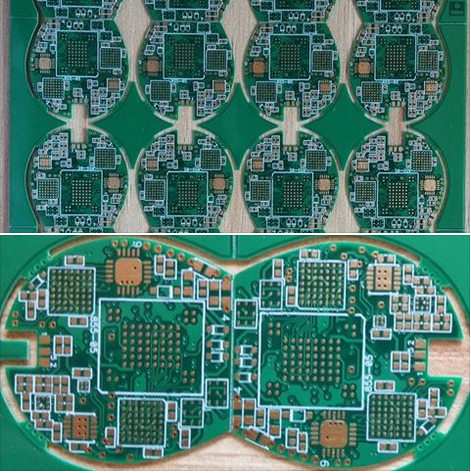PRODUCTS
High Speed High Frequency Board Skills

The world of electronics is shrinking, and with it, the signals used to power our devices are becoming faster and more frequent. This miniaturization necessitates a sophisticated understanding of high-speed high-frequency (HSHF) board design. Gone are the days when simple rules of thumb sufficed; today's circuits demand precise control over signal integrity, impedance matching, and electromagnetic interference (EMI) to ensure reliable operation. Failing to account for these factors can lead to signal degradation, data loss, and even complete system failure. This article delves into the critical skills needed to master the intricacies of HSHF board design, offering a glimpse into the challenges and solutions involved.
Understanding Signal Integrity
Signal integrity is paramount in HSHF design. High-speed signals, traveling at speeds approaching the speed of light, are susceptible to various distortions. These distortions can manifest as reflections, crosstalk, and jitter, all of which can severely impact data transmission. Understanding transmission line theory is crucial. This includes knowing how to calculate characteristic impedance, propagation delay, and reflections using parameters like dielectric constant and trace geometry. Sophisticated simulation tools, such as IBIS-AMI, are indispensable for predicting and mitigating these effects before fabrication.
Accurate impedance control is key. Every component and trace on the board contributes to the overall impedance, and deviations from the desired characteristic impedance can lead to signal reflections. Careful design of traces, including their width, thickness, and spacing from ground planes, is critical for maintaining a consistent impedance. The use of controlled impedance materials and manufacturing techniques is also essential to ensure accurate impedance matching throughout the board.
Controlling Crosstalk and EMI
Crosstalk, the unwanted coupling of signals between adjacent traces, is a significant concern in HSHF designs. High-speed signals generate electromagnetic fields that can induce currents in neighboring traces, leading to signal distortion and errors. Minimizing crosstalk requires careful routing and placement of components, often employing techniques like shielding, differential signaling, and appropriate spacing between traces. Careful consideration of the dielectric material between layers also plays a crucial role in reducing crosstalk.
Electromagnetic interference (EMI) is another major challenge. High-frequency signals radiate electromagnetic energy, which can interfere with other components and systems. To mitigate EMI, designers employ various techniques, including the use of ground planes, shielding enclosures, and proper filtering. Careful attention to power integrity is also crucial, as noisy power supplies can contribute significantly to EMI. Conformal coating can further minimize EMI radiation.
Advanced Routing and Layout Techniques
The physical layout of the board is critical for HSHF design. Careful routing techniques are needed to minimize signal path length, maintain consistent impedance, and reduce crosstalk. Strategies such as controlled impedance routing, differential pair routing, and return path optimization are essential. High-speed signals often require short, direct traces to minimize signal degradation.
The use of specialized CAD software with advanced routing capabilities is vital. These tools allow designers to simulate signal integrity and EMI before fabrication, enabling them to identify and address potential problems early in the design process. The ability to perform post-layout simulations is also crucial to validate the design's performance after routing is complete. Understanding stack-up design, including the placement and properties of dielectric layers and ground planes, is also fundamental to effective high-speed design.
Material Selection and Fabrication Processes
The choice of materials significantly impacts the performance of an HSHF board. Dielectric materials with low dielectric loss and a stable dielectric constant are essential for maintaining signal integrity. Similarly, the choice of substrate material and copper foil thickness influences impedance and signal propagation. High-frequency designs often utilize specialized materials, such as Rogers materials, which offer superior performance at high frequencies.
Precision manufacturing is also vital. Slight deviations in trace width, spacing, and thickness can significantly affect impedance and signal integrity. Controlled impedance manufacturing techniques, such as laser direct imaging, are often employed to ensure accurate trace dimensions. Thorough quality control throughout the manufacturing process is crucial to ensure the final board meets the required specifications.
Testing and Validation
Testing and validation are critical steps in HSHF board design. Various testing techniques, such as time-domain reflectometry (TDR), network analyzers, and oscilloscope measurements, are used to verify signal integrity and impedance matching. These tests help identify potential problems and ensure that the final product meets performance requirements. Eye diagrams and jitter measurements are commonly used to assess the quality of high-speed data transmission.
In conclusion, mastering HSHF board skills requires a deep understanding of signal integrity, impedance control, EMI mitigation, advanced routing techniques, material selection, and thorough testing. By combining theoretical knowledge with practical experience and advanced simulation tools, engineers can successfully design and fabricate reliable and high-performance HSHF boards that drive the innovations of modern electronics.
SUBSCRIBE
INQUIRY

